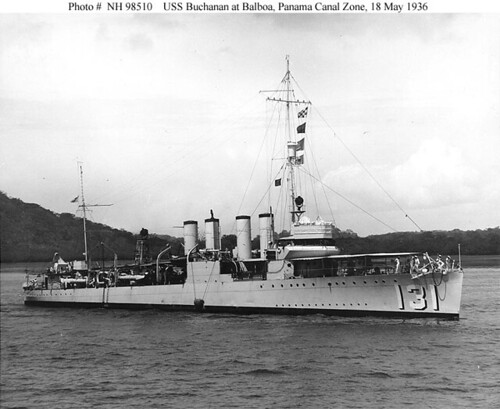skip to main |
skip to sidebar
Another Tin Can fighting above her weight. USS Buchanan (DD-131), later HMS Campbeltown. This really should be the for men, ships, and boats that took part in Operation CHARIOT, but let's look at the one who took it all to take out the dry docks at St. Nazaire. Here she is at her prime.
The force was first noticed at 01:15 but the first searchlights did not go on until 01:22 when the force was little more than 1.5 nautical miles (2.8 km) from the harbour. The British flew the Kriegsmarine ensign and used a German morse call sign and gained almost five more minutes, it was not until 01:28 with less than a mile to the harbour that the German guns opened fire and the White Ensign was hoisted. The Campbeltown drew the most fire but despite taking a number of casualties struck the southern caisson at around 20 knots (37 km/h) at 01:34, jamming herself deep into the structure and crumpling almost 40 feet (12 m) of her hull. The delay action fuses had been set shortly before the ship came under fire. The seven Commando teams then disembarked and made for their targets, successfully destroying much of the equipment associated with the Normandie Dock and also damaging the northern caisson. As these Commando groups withdrew and headed for the pier to embark they finally became aware of how the remainder of the force was faring.
...
The Campbeltown charges were timed to go off at around 09.00 at the very latest. A German search had not uncovered the explosive and the appointed time passed and it was not until 10.35 that the Campbeltown exploded, destroying the caisson and killing about 250 German soldiers and civilans in the vicinity. During the delay, senior German officers had arrived to inspect the damage. They were accompanied to the dock by two commando officers who had been taken prisoner. They knew what was about to happen, but remained silent, and died in the massive ensuing explosion. The reason for this delay in detonation has never been, and will never be, resolved. (The method used to detonate the explosives was an acid detonator, which was a notoriously unreliable system for triggering explosives, often detonating far earlier or later than expected. The heat in the ship is thought to have distilled off some of the acid in the detonators, resulting in a slower reaction. An alternative theory, put forward by some of the soldiers involved in the raid, is that one or more of the Commandos, having realised that the timers had failed, returned to the Campbeltown and manually detonated the charges.)
The explosive charges dropped by MTB 74 at the lock gates did not detonate until 30 March 1942 as expected. This late explosion shook the German garrison and led to a night of panic with German forces firing on French civilians and each other. Sixteen French civilians were killed and around thirty wounded. Later 1,500 civilians were arrested and taken to the camp at Savenay.
Despite the raid's very high casualty count, it was a great success - the dock was severely damaged and rendered unusable until 1947.










No comments:
Post a Comment